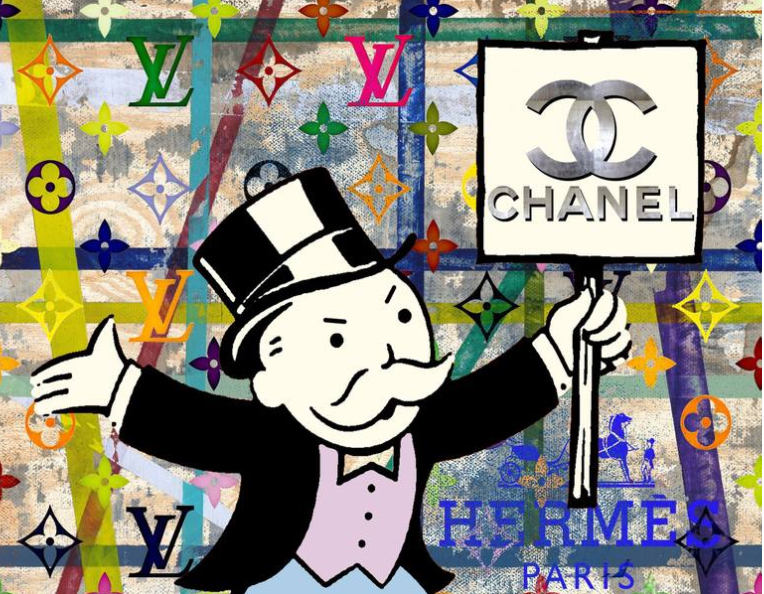The “Monopoly Chanel Protest Disaster No. 02” by Taylor Smith is a compelling piece that merges iconic imagery, luxury branding, and social commentary, creating a work that resonates deeply with both contemporary art collectors and critics of modern consumerism. This handmade artwork is executed on a painted birch panel, with a poured gloss resin finish that enhances its visual appeal, giving the work an added layer of depth and texture. The merging of different artistic elements—Monopoly’s familiar visual cues, the luxury of Chanel, and the thematic undertones of protest—makes this piece an intriguing exploration of the intersection of commerce, luxury, and dissent. In this delineation, I will explore the broader trends in art that this piece taps into, the significance of its materials and methods, and the conceptual framework that underpins its critique of consumer culture.
The Intersection of Monopoly, Chanel, and Protest
At first glance, “Monopoly Chanel Protest Disaster No. 02” is immediately arresting for its juxtaposition of elements that traditionally don’t belong together: Monopoly, the quintessential capitalist board game, and Chanel, a symbol of high-end luxury fashion. The inclusion of protest imagery further adds layers to the piece, suggesting a critical commentary on the convergence of capitalism and luxury branding in a world where dissent and protest are increasingly prevalent.
The use of Monopoly in the artwork provides a recognizable entry point for viewers. Monopoly has long been emblematic of capitalism, excess, and the pursuit of wealth, so much so that the game itself has become a cultural shorthand for critiques of economic inequality and the unchecked greed inherent in capitalist systems. By incorporating Monopoly as a central visual element, Taylor Smith taps into this collective cultural understanding, leveraging its iconic status as a vehicle for social commentary.
On the other hand, the incorporation of Chanel introduces a stark contrast—Chanel, with its association with exclusivity, high fashion, and refinement, symbolizes the pinnacle of luxury consumption. Chanel, like Monopoly, represents a type of aspirational excess, but in a vastly different context. While Monopoly deals with an abstract pursuit of wealth through fictional property trading, Chanel represents a very real form of wealth tied to material objects that have deep cultural value, especially in the fashion industry. By fusing the imagery of these two very different worlds, Taylor Smith raises questions about the ways in which capitalism, luxury, and protest collide in contemporary culture.
The presence of protest in the piece brings an additional layer of complexity. In today’s world, protest movements often stand in opposition to the systems that Monopoly and Chanel represent—capitalism, economic inequality, and the commodification of identity. The combination of these elements in the artwork forces the viewer to confront the uneasy relationship between consumerism and rebellion, luxury and dissent. Is the artwork critiquing the commodification of protest movements by luxury brands, or is it suggesting that even rebellion has become part of the capitalist system it seeks to dismantle?
Materials and Techniques: Painted Birch Panel and Resin Finish
The materiality of the piece plays a crucial role in its impact. Created on a painted birch panel, the work has an organic and textured base, which contrasts with the artificial gloss of the resin poured over it. The birch panel evokes a sense of craftsmanship and artisanal tradition, grounding the piece in the physical world. Birch, as a natural wood, has a raw, tactile quality that provides a counterpoint to the polished perfection of the luxury brand Chanel. It also harkens back to the tradition of handmade art, emphasizing the piece’s uniqueness in an era of mass production and consumerism.
The gloss resin finish, on the other hand, adds a modern and polished surface that transforms the piece into something sleek, reflective, and almost untouchable. This high-shine gloss evokes the sheen of luxury goods, from Chanel’s famous leather bags to the polished windows of high-end boutiques. The resin also creates a sense of depth, drawing the viewer in and making the imagery appear as though it is trapped beneath a glassy surface—untouchable, but alluring.
This duality of materials—natural and synthetic, textured and smooth—parallels the conceptual dichotomies present in the piece. On one hand, the artwork critiques luxury consumerism and capitalist greed; on the other, it is itself a luxury object, with its limited edition of only 20 copies adding to its exclusivity and collectibility. The resin finish elevates the work to the level of high art, giving it the same kind of fetishistic aura that surrounds high-end fashion items like those produced by Chanel.
Critique of Consumer Culture and the Commodification of Protest
At its core, “Monopoly Chanel Protest Disaster No. 02” is a critique of the ways in which consumerism has infiltrated every aspect of modern life, even protest. The use of Monopoly and Chanel as visual metaphors for capitalism and luxury signals a broader commentary on the way brands and corporations have co-opted symbols of dissent and rebellion. In recent years, we have seen luxury brands like Dior, Louis Vuitton, and even Chanel themselves incorporate elements of protest into their fashion shows, collections, and marketing campaigns. Slogans that were once associated with political movements have been transformed into design elements, printed onto T-shirts, bags, and jackets that sell for thousands of dollars.
Taylor Smith’s work seems to be engaging with this phenomenon, asking whether protest has lost its edge in a world where it has become just another form of brand expression. The piece raises difficult questions about authenticity and commodification: When luxury brands co-opt the imagery and language of protest, do they dilute its power? Or do they elevate it to a new level of visibility? And how do we, as consumers, engage with these contradictions when we buy into the luxury items that have appropriated these symbols of rebellion?
The Limited Edition and the Notion of Exclusivity
The exclusivity of the piece itself—limited to only 20 editions—adds another layer to its commentary on luxury and consumerism. Like a Chanel bag or an expensive piece of jewelry, this artwork is positioned as a collectible object, something rare and valuable in its own right. The fact that the piece critiques luxury and consumerism while simultaneously embodying those very qualities is a form of meta-commentary that further complicates the viewer’s relationship with the work.
Is the artwork itself a protest against the commodification of art and dissent, or is it an example of that very process? By limiting the availability of the piece, Taylor Smith mirrors the strategies of luxury brands, creating scarcity and desire through exclusivity. In doing so, he forces us to confront our own role as consumers in a system that thrives on exclusivity, scarcity, and the commodification of culture.
Impression
“Monopoly Chanel Protest Disaster No. 02” is a thought-provoking piece that masterfully blends familiar symbols of capitalism, luxury, and protest into a single, cohesive artwork. Through its use of Monopoly, Chanel, and protest imagery, Taylor Smith raises critical questions about the nature of consumer culture and the ways in which dissent is commodified by the very systems it seeks to challenge. The materiality of the piece—its handmade birch panel and high-gloss resin finish—mirrors these conceptual tensions, juxtaposing the organic with the synthetic, the handcrafted with the polished. Ultimately, the piece invites viewers to reflect on their own complicity in the systems it critiques, even as they are drawn to its undeniable allure as a luxury object.
No comments yet.








